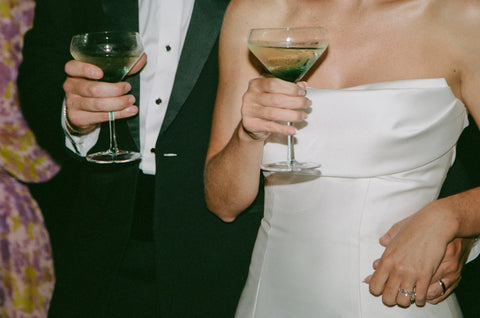"Semi-formal" is one of the least descriptive terms of all the wedding dress codes. Sitting somewhere between black-tie elegance and business casual simplicity, semi-formal wedding attire requires thoughtful consideration—especially for men who want to look appropriate without appearing overdressed or underdressed.
As wedding style experts with over a decade of experience outfitting grooms and guests alike, we've created this comprehensive guide to eliminate the guesswork and ensure you look your absolute best.
Table of Contents
- What Exactly Is "Semi-Formal" Wedding Attire?
- The Perfect Semi-Formal Suit Options
- Essential Components of Men's Semi-Formal Wedding Attire
- Accessorizing Your Semi-Formal Wedding Look
- Seasonal Considerations
- Semi-Formal By Venue Type
- Common Mistakes to Avoid
- Rent vs. Buy Decision Guide
- Semi-Formal Outfit Checklist
- Final Thoughts
What Exactly Is "Semi-Formal" Wedding Attire?
Semi-formal wedding attire occupies the middle ground in the formality spectrum. It's more polished than cocktail attire, casual, or smart casual dress codes, but less rigid than what formal or black-tie would require.
Historically, semi-formal emerged in the early 20th century as social occasions became more diverse and dress codes began to relax from strict Victorian standards. Today, it represents a balance between respect for the significance of a wedding while allowing for personal style and comfort.
The semi-formal dress code varies slightly based on the time of day:
- Daytime semi-formal: Lighter colors are acceptable (medium-to-dark gray, navy blue)
- Evening semi-formal: Darker suits are preferred (charcoal, navy, or black)
On the formality spectrum, here's where semi-formal falls:
- Ultra-formal: White tie, tails
- Formal: Black tie, tuxedo
- Semi-formal: Dark suit with appropriate accessories
- Cocktail: Suit with more creative color/styling choices
- Business casual: Dress pants with blazer, no tie necessary
- Casual: No jacket required, collared shirt
The Perfect Semi-Formal Suit Options
The cornerstone of men's semi-formal wedding attire is a well-tailored suit in an appropriate color in context. Here's what you need to know about selecting the right suit:
Suit vs. Tuxedo: Know the Difference
For semi-formal weddings, a suit is the appropriate choice—not a tuxedo. Tuxedos feature satin lapels, satin stripes on the pants, and are traditionally worn with bow ties, making them too formal for a semi-formal event.
Color Selection
The perfect semi-formal suit colors depend on several factors:
- Evening weddings: Charcoal gray, navy blue, or black
- Daytime weddings: Navy, medium-to-dark gray, or subtle patterns
-
Seasonal considerations:
- Spring/Summer: Navy, lighter grays, occasionally lighter blues
- Fall/Winter: Charcoal, dark navy, black
Fabric Choices
Select fabrics based on both the season and venue:
- Warm-weather fabrics: Lightweight wool, tropical wool, wool-linen blends
- Cold-weather fabrics: Medium-to-heavyweight wool, flannel, subtle tweed
- Year-round options: Four-season wool
Fit Considerations
Regardless of your body type, proper fit remains the most important aspect of looking good in semi-formal attire:
- Jacket sleeves should end at your wrist bone, revealing ¼-½ inch of shirt cuff
- Jacket shoulders should align with your natural shoulders—no sagging or pulling
- Pants should have a slight break or no break (touching the top of your shoes without bunching)
- Jacket should be able to button comfortably without pulling
Essential Components of Men's Semi-Formal Wedding Attire
Jackets & Suits
For semi-formal weddings, a complete matched suit is essential—blazers don't complete the assignment. The jacket forms the centerpiece of your look, with notch lapels being the standard and universally appropriate for semi-formal occasions. Peak lapels can add a touch of sophistication while still adhering to the dress code. Side vents are the preferred style for semi-formal attire as they allow for movement and provide a more flattering drape than center vents.
When it comes to buttons, the two-button suit is the most versatile option. While three-button styles are acceptable, they're slightly more traditional and can sometimes appear dated if not perfectly tailored.
Pants
In the semi-formal world, a matched suit is non-negotiable, so your pants should match your jacket. Flat-front pants are more common in contemporary semi-formal attire, but pleated styles (like peak lapels on the jackets) can create visual interest and help you stand out in a subtle way.
The proper break (where your pants meet your shoes) makes a significant difference in your overall appearance. A slight break or even no break presents a cleaner, more modern line that works particularly well for semi-formal occasions. Your pants should ideally be mid-rise, sitting at your natural waist to create the most flattering proportion with your jacket. The width should follow a moderate taper—neither skinny nor wide—giving your outfit a timeless look that won't look dated in wedding photos years later.
Shirts
The foundation of your semi-formal look starts with the right dress shirt. White or light blue colors are the safest choices, with subtle patterns acceptable (usually for daytime events). Standard point collars or semi-spread collars work universally well for most face shapes and tie styles.
For cuffs, barrel (button) cuffs are standard and appropriate for most semi-formal occasions, while French cuffs offer a slightly more elevated option that works particularly well for evening events. Fabric quality matters—100% cotton shirting provides the ideal balance of quality, comfort, and practicality. Your shirt should have no billowing at the waist and should close comfortably at the neck without constriction or gaps, so mind the fit.
Footwear
Your choice of shoes can elevate or undermine your entire semi-formal outfit. For semi-formal weddings, leather dress shoes are the best move—oxfords, derbies, or formal loafers are all appropriate choices. If you really want to follow this dress code closely, avoid suede, as it's a more casual option.
Here's a simple rule for choosing shoe color: black leather for evening events, with dark brown as an acceptable alternative for daytime occasions. Complete the look with mid-calf or over-the-calf dress socks that match your pants (not your shoes) to maintain a continuous line when seated.
Accessorizing Your Semi-Formal Wedding Look
The right accessories elevate a basic suit to proper semi-formal attire while allowing for personal expression. These finishing touches often distinguish the merely adequately dressed from the truly well-dressed gentleman.
Neckwear
Your neckwear choice is one of the most important style decisions you'll make for semi-formal occasions. Silk ties are the standard choice, providing a balance between timeless appeal and contemporary styling. Color and pattern selection should reflect both the season and the time of day—solid colors, subtle patterns, or classic stripes all work well.
Opt for lighter or brighter ties for spring and summer events, while reserving deeper, richer colors for fall and winter celebrations. While bow ties are technically acceptable for semi-formal occasions, they're less common and tend to push the outfit more toward cocktail attire rather than true semi-formal. When in doubt, a well-chosen necktie presents the safer option.
Pocket Squares
A pocket square adds sophistication to your semi-formal ensemble without overwhelming it. For traditional semi-formal events, keep your fold styles simple and elegant—the TV fold (straight) or a single point work perfectly for these occasions. The coordination between your pocket square and tie requires a delicate balance: they should complement each other without matching exactly, which would appear overly calculated.
The material should reflect both the season and the formality level, with silk being appropriate year-round and linen providing a nice option for warmer months. Proper placement matters—just 1/4 to 1/2 inch should be visible above the pocket, offering a subtle accent rather than a bold statement.
Watches & Jewelry
Semi-formal attire calls for restraint in jewelry, with quality trumping quantity. Select dress watches with leather straps or refined metal bands that complement the formality of the occasion. The metals in your accessories should coordinate with one another—silver, gold, or mixed metals should maintain a cohesive look across your cufflinks, watch, and any other metal elements.
If wearing a French cuff shirt, choose cufflinks with simple, elegant designs in silver or gold. Avoid novelty or overly casual styles for semi-formal weddings. Rings should be kept to a minimum—your wedding band and perhaps one additional ring at maximum provides sufficient adornment without appearing ostentatious.
Boutonnieres
If wearing a boutonniere as part of the wedding party, opt for small, understated designs that complement without overwhelming your lapel. Proper placement is critical—it should be positioned on the left lapel, ideally through the lapel's buttonhole if available. The boutonniere should complement the wedding flowers without matching them exactly, creating a harmonious connection to the overall wedding design without appearing contrived.
Seasonal Considerations
Summer Semi-Formal Attire
Warm-weather semi-formal attire requires strategic adjustments to maintain both comfort and style. The summer months call for thoughtful fabric selection, with lightweight wool or tropical wool offering the ideal balance between appropriate formality and practical breathability. These fabrics maintain a crisp, structured appearance while allowing sufficient airflow to keep you comfortable even during outdoor ceremonies.
Stay conservative with color selection even in summer — navy and medium-to-light gray are the most appropriate options. Shirts should be chosen with comfort in mind—lightweight cotton with good breathability will serve you well during warmer celebrations. Time of day offers some flexibility, as earlier daytime weddings may allow for slightly lighter color palettes than evening events.
Winter Semi-Formal Attire
Cold-weather semi-formal attire allows for medium-to-heavyweight wool, flannel, or subtle tweed, all of which offer both warmth and texture. These fabrics not only provide practical insulation but also drape beautifully, creating a refined silhouette particularly suited to winter events.
Layering becomes both practical and stylish during colder months, with waistcoats (vests) adding warmth while elevating your overall appearance. Color selection should skew darker in winter, with charcoal, dark navy, and black representing the most appropriate choices. Approach accessories as opportunities for subtle seasonal adaptations—consider incorporating ties and pocket squares with richer textures like silk knits or lightweight wool that complement the season without compromising formality.
Spring/Fall Considerations
Transitional seasons offer the most flexibility in semi-formal attire, allowing for adaptable approaches to changing conditions. Wool works perfectly during these months, providing versatility to handle both warmer days and cooler evenings. Your color palette can include the full range of appropriate semi-formal options, from darker to medium tones depending on the specific event details.
Be prepared for a change in the weather during these changeable seasons. Layering strategies play a crucial role during spring and fall—waistcoats become optional but useful additions that can be incorporated or removed as temperature fluctuations demand, ensuring comfort throughout the celebration.
Semi-Formal By Venue Type
Beach/Destination Wedding Semi-Formal
Tropical and beach settings allow for specific adaptations while maintaining semi-formal standards:
- Fabrics: Lightweight wool, wool-linen blends, or high-quality cotton suits
- Colors: Navy, medium blue, or light gray
- Considerations: Slightly more relaxed fit acceptable; unlined jackets appropriate
- Footwear: Leather shoes still required (no sandals or casual footwear)
Rustic/Barn Wedding Semi-Formal
Country settings permit subtle style adjustments:
- Texture: More texture appropriate (subtle tweed, textured wool)
- Colors: Navy, gray, or subtle patterns like glen plaid
- Details: Suspenders might be incorporated as a stylistic choice
- Accessories: Slightly more personality in ties and pocket squares
Traditional Venue Expectations
Ballrooms, hotels, and traditional venues require adherence to classic semi-formal standards:
- Execution: Precise fit and finish become even more important
- Colors: Stick with darkest and most classic options
- Details: French cuffs and cufflinks more appropriate here
- Formality level: Err on the dressier side of semi-formal
Urban/Contemporary Setting Adjustments
Modern venues allow for contemporary interpretations of semi-formal:
- Silhouette: Slightly trimmer cuts can work well
- Details: Modern touches like ticket pockets or unique buttons acceptable
- Styling: Monochromatic looks (navy suit, navy tie) can work effectively
- Accessories: More room for personality while maintaining the dress code
Common Mistakes to Avoid
Over-dressing vs. Under-dressing
Getting the level of formality right is perhaps the most common challenge with semi-formal attire. Wearing a tuxedo to a semi-formal wedding inappropriately upstages the dress code and may make you appear more formally dressed than the groom. On the other hand, arriving in separates like a sports coat with non-matching pants falls below the minimum threshold for semi-formal attire. Fabric selection plays a crucial role in hitting the right note—avoid casual materials like linen-only, seersucker, or corduroy, which aren't formal enough regardless of how they're styled.
Fit Issues
No matter how much you nail your garment selection, a bad fit will undermine your entire look. Watch out for oversized jackets with shoulders extending beyond your natural shoulder line, or a too-tight suit that pulls at the buttons or restricts movement. Proper proportions matter—jackets should cover your seat, sleeves should end at the wrist bone, and pants should break cleanly over your shoes without excess fabric puddling around your ankles.
Accessory Mistakes
Going too big or loud (think: novelty ties, themed cufflinks, silly socks), or too minimal (skipping the tie fails to meet semi-formal requirements) reveal a fundamental misunderstanding of the semi-formal dress code. Footwear selection frequently trips up otherwise well-dressed men; sneakers, boat shoes, or suede options are all too casual for semi-formal events regardless of their color or styling. Over-accessorizing can also be a problem. Remember, the beauty of formality and a dress code is in its simplicity.
Color Combination Errors
Overly bright or vibrant colors are a no-go in semi-formal attire. Seasonal mismatches — like wearing pastel suits to winter weddings or dark flannel to summer celebrations — are forgivable but avoidable. Perhaps the most common error involves poor pattern and color coordination—clashing patterns or competing strong colors create a disjointed appearance that lacks the harmonious, intentional look that defines well-executed semi-formal attire.
Rent vs. Buy
Deciding whether to purchase or rent your semi-formal attire depends on several factors:
When Renting Makes Sense
- Infrequent use: You rarely attend semi-formal events
- Changing size: Your weight fluctuates or you're still growing
- Budget considerations: Quality rentals provide better value than low-end purchases
- Convenience: Home try-on programs eliminate guesswork
- Variety: Access to different styles for multiple weddings
When Purchasing Is Preferable
- Regular wear: You attend multiple formal events per year
- Investment perspective: Quality suits can last years with proper care
- Perfect fit: Time for multiple alterations ensures ideal fit
- Long-term value: Cost-per-wear decreases with frequent use
Quality Considerations
- Construction: Half-canvas or full-canvas construction provides better drape
- Fabrics: Wool offers the best balance of quality and durability
- Alterations: Quality rentals include basic alterations; purchases may require additional tailoring
Semi-Formal Outfit Checklist
Essential Items
Creating a complete semi-formal look requires attention to every component. Start with the foundation: a matched suit in an appropriate color and fabric that aligns with the season and time of day. Select a proper dress shirt in white or light blue, which will work with virtually any suit color. Your necktie should coordinate with both your suit and the overall occasion, creating a harmonious look without completely matching other elements.
Footwear demands equal consideration—leather dress shoes in either oxford or derby styling provide the appropriate level of formality, while proper dress socks (mid-calf or over-the-calf) keep your ankles covered when seated, which is technically correct for this dress code. Complete your look with an appropriate belt that matches your shoes. Finally, add a pocket square that complements your tie without matching it exactly for a sophisticated finishing touch.
Day-Of Preparation
Even the best-planned outfit requires proper day-of execution. Begin by ensuring your garments are properly pressed—steam or iron your shirt and touch up your suit if needed to remove any wrinkles that developed during storage. Emergency supplies might sound over-the-top (think: stain remover wipes, a lint roller, and maybe an extra shirt), but trust us. If you don't use it, someone else likely will.
And give yourself time to get dressed. Semi-formal attire involves multiple components that deserve careful attention, and rushing can lead you to overlook the details. Before you head to the wedding, perform a final check of all elements: tie properly knotted, pocket square correctly positioned, and overall appearance neat and intentional. This approach ensures you'll arrive looking polished and prepared to celebrate.
Final Thoughts
Semi-formal wedding attire strikes the perfect balance between honoring the significance of the occasion and allowing for personal comfort and style. By understanding the core principles—appropriate suit selection, proper fit, correct accessories, and seasonal adaptations—you'll navigate this dress code with confidence.
Remember: rules provide structure, but the ultimate goal is to look polished, appropriate, and comfortable while celebrating a special occasion. With this guidance, you'll be dressed for any semi-formal wedding invitation that comes your way.
Need personalized assistance with your semi-formal wedding attire? Our expert stylists can help you find the perfect look for any wedding, whether you're the groom, a groomsman, or a guest. Book a fitting at our showroom, and we'll help you prepare for your next event.















